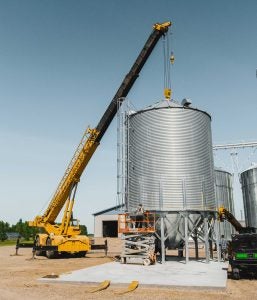The combination of yields and commodity pricing can put a premium on grain storage strategies, including the right grain bin air system
Grain storage represents a perpetual paradox for farmers. When yields are high and prices low, grain bins are in demand, and grain storage comes at a cost. And times like these makes aeration strategies all the more critical.
With this season’s yields looking to burst estimates, farmers need grain-bin aeration strategies for what could be a long winter. For a number of reasons swirling against them, farmers in many parts of the country were forced to move much of 2019’s harvest into winter storage, and getting it out to market has been a struggle as yet more grain comes in this fall. Grain spoilage has been an issue with warmer than normal summer temperatures and problems like blue-eye mold developing in stored corn. The 2020 crop looks to be bigger yet, with a new survey by Farm Futures predicting corn yields to increase 11.5 bushels per acre from 2019 up to 178.9, for a predicted total of 15.03 billion bushels. Soybeans are predicted to average 51 bushels per acre in 2020, up 3.6 from 2019.

This wouldn’t be the first year where grain-bin storage was at a premium. And frankly, building more bins might be what is needed. But with new bins comes new considerations including costs and, thankfully, new technology largely aimed at aeration.
Here are five aeration strategies to consider for grain storage:
1. Build state-of-the-art bins
Grain production will most likely continue rising due to advancing hybrids and technology, but this doesn’t mean prices will improve. Growing forward, more storage capacity will be needed. Building new bins with advanced grain-bin air systems in mind might be the answer. For example, one company out of Manitoba, Canada, specializing in this area is NorBin. Bringing a brand new approach to the task, the company offers both a newly built NorBin Hopper with a patent-pending full-floor air system, as well as a NorBin Retrofit model designed to fit within an existing hopper, using the same full-floor air system. NorBin’s system eliminates any unaerated pockets of grain in the bin, an innovative step in the industry of stored grain aeration. The NorBin packages come in four different sizes — 18 feet, 21 feet, 24 feet, and 27-feet — and they can be custom built. The products are made from 100 percent galvanized steel, which provides years of rust-free grain storage. No grain is left behind in this design with a self-cleaning ventilation system, where all the grain spills out when the bin is emptied.

2. Management through observation
If a farmer stacked $300,000 in individual dollar bills inside a grain bin, you can be sure he’d check to ensure it wasn’t molding or rotting over the winter. Whether in a new or old grain bin, observation of dry grain storage is a must. Officials at the land-grant Purdue University recommend checking the grain weekly during fall and spring months, when outside air temperatures are changing rapidly. During winter, grain should be checked every two months. Search for small changes and look at the surface area for indications of crusting-wet, sticky, or frozen grain. Observe the roof for evidence of condensation and stick your arm deep into the grain to feel for warmth, all the while smelling for musty odors. If the grain is going to be stored into July and August, consider warming it with the aeration fan. This also applies if the grain was accidentally frozen. Spring warm-ups can prevent moisture migration. A good rule of thumb is to start the fan when the average outdoor temperature is 10 to 15 degrees F above grain temperature. During summer, do not warm the grain to high temperatures (89 to 90 degrees F). Aerate as needed but stop the spring warm-up at about 50 to 60 degrees F.
3. Factor in all grain storage costs in advance
Given the value of the product inside a grain bin, you’d think folks would figure out the all the details in advance, given that storage strategies in terms of air flow and temperature change between November and July. Don’t get caught in the summer with storage expenses beyond your capacity and wind up with spoiled grain. Purdue University’s Extension System recommends the equation as follows. Operating cost hours x kilowatts (kW) x cents/kilowatt-hour (kWh). For estimating, assume that 1 hp = 1 kilowatt. Therefore the, operating cost is approximately equal to fan horsepower x hr x cents/kWh. Proper cooling and warming of a grain bin rarely exceeds 1/10 cents per bushel for electricity, but consider the duration in terms of days, weeks, and months. Farmers found themselves holding 2019 grain much longer than they’d expected, and those fractions of pennies add up.

4. Different moisture contents
Different levels of moisture are acceptable for different grains depending on how long they’ll be stored. Per University of Minnesota recommendations, short-term storage means through June, and that should involve: 15.5 percent moisture content in shelled corn; 13 percent moisture content in soybeans; and 14 percent moisture content in wheat/barley. For one-year storage: 14 percent moisture content in shelled corn; 12 percent moisture content in soybeans; and 13 percent moisture content in wheat/barley. For long-term storage: 13 percent moisture content in shelled corns; 11 percent moisture in soybeans; and 13 percent moisture content in wheat/barely. Acceptable moisture contents are thus very time-dependent, and if the 2020 harvest winds up in longer-term storage, like 2019, then figure aeration in a grain bin or hopper tank will be an ongoing concern.
5. Pest control
Correctly storing grain minimizes the risk of pest infestation, which can range from insects to rats. The checklist to run for this issue begins with cleaning all debris from harvest, including the handling and drying equipment. Next, sweep all old grain and particles from the bin, and make sure to check under the perforated flooring. Repair the bin for signs of water leakage as this represents holes where insects could invade and apply the proper insect repellent to the area. Also, try to remove piles of boards, spilled grain, or vegetables from around the outside of the bin as this attract pests. Finally, avoid stacking new grain on top of old grain, as even a few bugs in the mix can contaminate the whole grain bin.

Whether this season brings a bumper crop or not, good aeration strategies are must when using grain bins. Grain bin air systems in general require regular upkeep and maintenance, but a lot of aeration strategy really just comes down to common sense and follow-through. But if newer bins, or perhaps remodeled versions of existing bins, are in order, there are indeed examples of improved technology for aeration to consider.
This article was published on behalf of NorBin.
Brian Boyce is an award-winning writer living on a farm in west-central Indiana. This article was published on behalf of NorBin.



